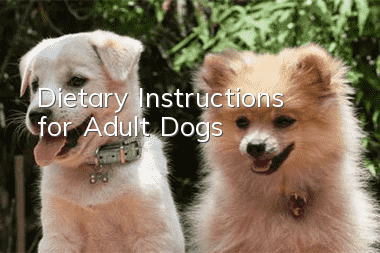Dietary Instructions for Adult Dogs

Like other animals, dogs also rely on food to obtain energy. A food with the right amount of energy for each dog should also provide all the necessary nutrients, and these nutrients should be balanced. Sugar and fat are the basic sources of energy, but dogs also get energy from protein. Although sugar can provide energy for dogs, it is not necessary for dogs.
A balance of energy is vital to maintaining a dog's health at different stages of its life. Too little energy intake can lead to leanness, while too much energy intake can lead to obesity and complications - for example, bone deformation in large dogs.
A dog's energy needs depend on its level of activity, for example, whether it works, lives indoors or outdoors, is sick, is old or growing, etc. Female dogs during pregnancy and lactation also need to consume a lot of energy. If your dog becomes less active as he gets older, you may want to reduce the amount of food he is fed to avoid obesity.
If you use commercial pet food, the label on the package will indicate the feeding amount. But remember, this feeding amount is a guide only and you should make some adjustments based on your dog's needs. If it is very active, it needs to eat more, if it is very quiet, it needs to eat less. And don't forget to take into account some of the other foods he eats - including the calories in cookies and other snacks.
The most convenient way to monitor your dog’s eating habits and health is to observe it. If the dog is alert and bright-eyed, and is neither fat nor thin, it is likely to be in good health and have a balanced nutritional intake.
If your dog is gaining weight, you may be overfeeding. You should reduce the amount of food you offer or reduce the number of biscuits when feeding meat and biscuits to give it a balanced diet.
Most adult dogs 9 months of age or older can eat one meal a day, but they can be fed twice a day if it is convenient for you or if it would be beneficial to the dog. above. For puppies, since their stomachs are small, it is best to feed them twice a day.
Similarly, young dogs, working dogs, pregnant bitches, lactating bitches, sick dogs, and dogs in recovery usually need to be fed multiple times a day. You should ensure that your dog eats the appropriate amount and frequency of meals each day.
Adult dogs--little activity
Small dogs with less than 1 hour of activity per day:
This kind of dog needs 110 kcal to 620 kcal per day. Because of its low activity level, you must ensure that it eats moderate amounts, otherwise, it will become obese easily. Don't feed it leftovers as this will significantly increase its energy intake. If possible, try to increase the amount of activity to 1 to 2 hours a day. Remember, all energy intakes given here are for reference only. Even if each dog has the same weight and activity level, the caloric requirements will not be the same, and there will also be some differences between different breeds of dogs.
Medium-sized dogs with less than 1 hour of activity per day:
This kind of dog needs 620 to 1230 kcal per day. Due to its low activity, you must ensure that it eats a moderate amount, otherwise, it will easily become fat. Don't feed it leftovers as this will significantly increase its energy intake. If possible, try to increase the amount of activity to 1-2 hours a day. Remember, all energy intakes given here are for reference only. Even if each dog has the same weight and activity level, the caloric requirements will not be the same, and there will also be some differences between different breeds of dogs.
Large dogs with less than 1 hour of activity per day:
This kind of dog needs more than 1230 kcal per day. This range is very large. For example, a giant dog weighing more than 100 kilograms requires approximately 3,500 kcal per day. Because of its low activity level, you must ensure that it eats moderate amounts, otherwise, it will become obese easily. Don't feed it leftovers as this will significantly increase its energy intake. If possible, try to increase the amount of activity to 1-2 hours a day. Remember, all energy intakes given here are for reference only. Even if each dog has the same weight and activity level, the caloric requirements will not be the same, and there will also be some differences between different breeds of dogs.
Adult dogs--moderate activity level
Small dogs with 1 to 2 hours of activity per day:
This kind of dog needs 125 to 700 kcal per day. This amount of activity is just right for a typical pet dog, so it must be maintained every day. In cold weather, especially if your dog lives in an outdoor kennel without heating, increase the amount he is fed. This is because when the weather gets colder, the amount of energy required to maintain body temperature increases. So, in this case, you only need to increase the amount of complete, balanced nutritional foods. Don't feed leftovers because, while this provides more energy, it doesn't provide the other nutrients needed for a balanced diet. Remember, all energy intakes given here are for reference only. Even if each dog has the same weight and activity level, the caloric requirements will not be the same, and there will also be some differences between different breeds of dogs.
Medium-sized dogs with 1-2 hours of activity per day:
This kind of dog needs 700 to 1400 kcal per day. This amount of activity is just right for a typical pet dog, so it must be maintained every day. Increase the amount your dog is fed during cold weather, especially if he lives in an outdoor kennel without heating. This is because when the weather gets colder, the amount of energy required to maintain body temperature increases. So, in this case, you only need to increase the amount of complete, balanced nutritional foods. Don't feed leftovers because, while this provides more energy, it doesn't provide the other nutrients needed for a balanced diet. Remember, all energy intakes given here are for reference only. Even if each dog has the same weight and activity level, the calories it needs will not be the same, and differentThere are also some differences between breeds of dogs.
Large dogs with 1-2 hours of activity per day:
This kind of dog needs more than 1,400 kcal per day. This range is very large. For example, a giant dog weighing more than 100 kilograms requires approximately 3950 kcal per day. This amount of activity is just right for a typical pet dog, so it must be maintained every day. Increase the amount your dog is fed during cold weather, especially if he lives in an outdoor kennel without heating. This is because when the weather gets colder, the amount of energy required to maintain body temperature increases. So, in this case, you only need to increase the amount of complete, balanced nutritional foods. Don't feed leftovers as while this may provide more energy, it does not provide the other nutrients needed for a balanced diet. Remember, all energy intakes given here are for reference only. Even if each dog has the same weight and activity level, the caloric requirements will not be the same, and there will also be some differences between different breeds of dogs.
Adult dogs--moderate to high activity level, large activity level
Small dogs with 2-3 hours of activity per day:
This kind of dog needs 150 to 840 kcal per day. This amount of activity is greater than that required by a typical pet dog. Moreover, it may not necessarily maintain this level of activity every day. The dog's weight and physical condition should be checked regularly, and its feeding amount should be adjusted accordingly.
Medium-sized dogs with 2-3 hours of activity per day:
This kind of dog needs 840 to 1680 kcal per day. This amount of activity is greater than that required by a typical pet dog. Moreover, it may not necessarily maintain this level of activity every day. The dog's weight and physical condition should be checked regularly, and its feeding amount should be adjusted accordingly.
Large dogs with 2-3 hours of activity per day:
This kind of dog needs more than 1680 kcal per day. This amount of activity is greater than that required by a typical pet dog. It is impossible for a giant dog to maintain this level of activity every day. The dog's weight and physical condition should be checked regularly, and its feeding amount should be adjusted accordingly.
Adult dogs--various types of high activity levels:
This section only applies to dogs that are particularly active, that is, dogs that spend most of their day in motion. Their energy needs are 40% or more greater than corresponding moderately active dogs, especially when exposed to harsh environments, such as extremely low or high temperatures. Their food intake is large (2 to 4 times normal) and should be fed in multiple portions. Most food should be fed after work is over and the dog has rested and regained its strength. The remaining portion should be fed at an appropriate time before activity. Since large amounts of water will be required for cooling, it is particularly important to ensure that there is an adequate supply of fresh water (ideally unlimited).
- The dog was dewormed and kept pulling out live worms intermittently
- Dog's eyes have yellow pus-like mucus
- Why is Teddy crying?
- Does a Bichon Frize only recognize one owner?
- The puppy's stomach twitches
- What does it look like if a dog eats too much and has diarrhea?
- What should a golden retriever eat to make more milk after giving birth?
- How old does Teddy look like when he is 11 months old? The age of dogs is different from that of humans.
- How do you know your dog is uncomfortable? These actions are signs of discomfort!
- Why do dogs like to roll on the ground? It turns out there are so many secrets...



